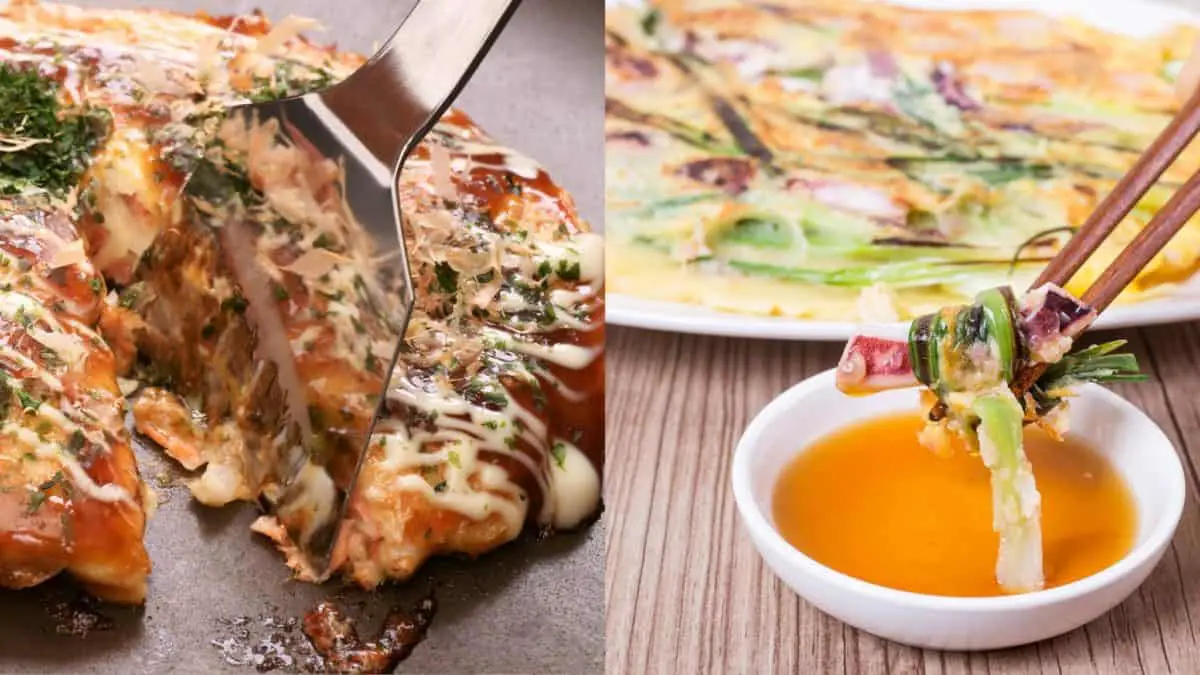Japanese Okonomiyaki VS Korean Pajeon Pancake
If you’re a fan of both Japanese and Korean cuisine, then you’re in for a real treat. Today, we’re going to compare and contrast two popular pancake dishes:
Both okonomiyaki and pajeon are savory flour and egg pancakes. Pajeon uses more non-wheat flour, more oil when frying, and a more salty soy sauce dip on the side, while okonomiyaki is mostly wheat flour making it denser, more cooked than fried, and topped with mayo and sweet sauce.
You may be wondering which dish is better. Well, that’s up to you to decide! But I can tell you that both okonomiyaki and pajeon are absolutely delicious, and I’ll talk you through the differences and similarities.

Okonomiyaki always has been the more popular of the two, at least worldwide speaking, but in 2005 their popularity grew further apart as interest in okonomiyaki and Japanese food rose.
Okonomiyaki VS Pajeon Popularity by quarter

Check out our new cookbook
Bitemybun's family recipes with complete meal planner and recipe guide.
Try it out for free with Kindle Unlimited:
Read for freeIn this post we'll cover:
What is okonomiyaki?

Okonomiyaki is a savory pancake that originates from Osaka, Japan. It’s made with wheat flour, egg, cabbage, and your choice of protein (usually pork or shrimp).
Once it’s cooked, it’s topped with various sauces and toppings, such as mayonnaise, soy sauce, and bonito flakes.
What is Pajeon?

Korean Pajeon is a savory pancake made with wheat flour, egg, green onion, and your choice of protein (usually seafood). Once it’s cooked, it’s drizzled with a soy sauce-based dipping sauce.
Differences & similarities
Okonomiyaki and Pajeon both have a pancake-like texture, but okonomiyaki is more dense and heavy, while Pajeon is light and fluffy.
In terms of flavor, okonomiyaki is savory with a slight sweetness, while Pajeon is more savory and salty.
Toppings and sauces
One of the main differences between the two dishes is the toppings and sauces. Okonomiyaki is typically topped with mayonnaise, soy sauce, and bonito flakes, while Korean Pajeon is usually served with a soy sauce-based dipping sauce on the side.
The cabbage is almost mandatory with okonomiyaki, all other ingredients are “fry as you like it”, which is the translation of okonomi and yaki, okonomiyaki. So there are a lot of variations of toppings like bacon and seafood.
Pajeon has its mandatory scallions, Pa means “scallions,” and Jeon means “pan-fried or battered”, Pajeon.
The most popular recipe is with seafood.
Differences in cooking style
Another difference between the two dishes is the cooking style. Okonomiyaki is more cooked than fried on a flat griddle, while Pajeon is fried in a pan, usually with a lot more oil than with okonomiyaki, resulting in an almost deep-fried pancake.
That’s why pajeon is cripier than okonomiyaki.
Is Korean pancake mix the same as okonomiyaki?
Korean pancake mix is not the same as okonomiyaki, there are a few key differences.
- The first difference is in the seasoning: Okonomiyaki is a little sweeter and has dashi as its main flavoring ingredient. At the same time, Korean pancake mix is known for the savory flavor profile with a lot more spices like garlic, onion, and pepper already “baked” into the mix.
- The second difference is the type of flour: Okonomiyaki mostly has wheat flour with a bit of baking powder, which lends itself great to the flat grill cooking style without a lot of oil to get to a cooked inside and slightly crispy outside. Korean pancake mix uses wheat flour with many non-wheat flours like tapioca-, rice-, and potato flour to give it the texture needed for deep-frying.
Origin of okonomiyaki and pajeon
Okonomiyaki is believed to have originated in Osaka, Japan, in the early 1900s. It’s said that okonomiyaki was created as a way to use up leftovers.
Pajeon is believed to have originated in Korea during the Joseon dynasty (1392-1910). It’s said that Pajeon was created in honor of the victory of the people of Dongnae (a district in the city of Busan) over the invading Japanese soldiers.
The people threw scallions at the invading Japanese soldiers, so when the victory was theirs, they decided to use that as a symbol and make a victory dish out of it.
Conclusion
If you like Asian pancakes, then these two would make your mouth water, but as I’ve shown, there are some key differences.
These differences reflect the cooking styles of their countries, and it’s wonderful to taste the cultural differences in the food.
Also learn about the difference between Korean and Japanese BBQ
Check out our new cookbook
Bitemybun's family recipes with complete meal planner and recipe guide.
Try it out for free with Kindle Unlimited:
Read for freeJoost Nusselder, the founder of Bite My Bun is a content marketer, dad and loves trying out new food with Japanese food at the heart of his passion, and together with his team he's been creating in-depth blog articles since 2016 to help loyal readers with recipes and cooking tips.
